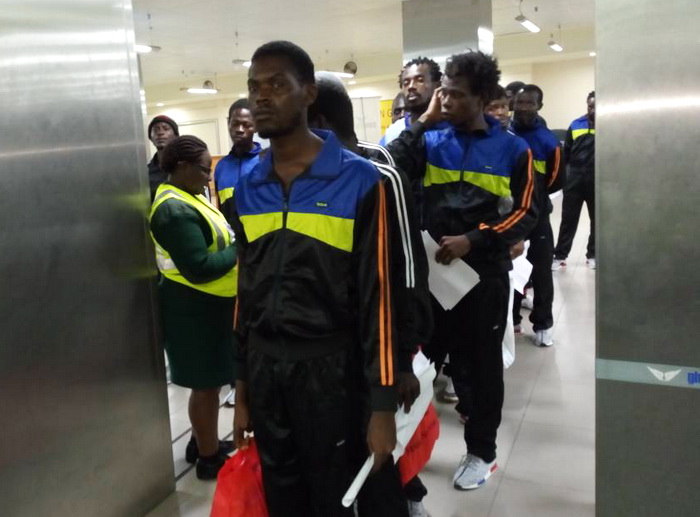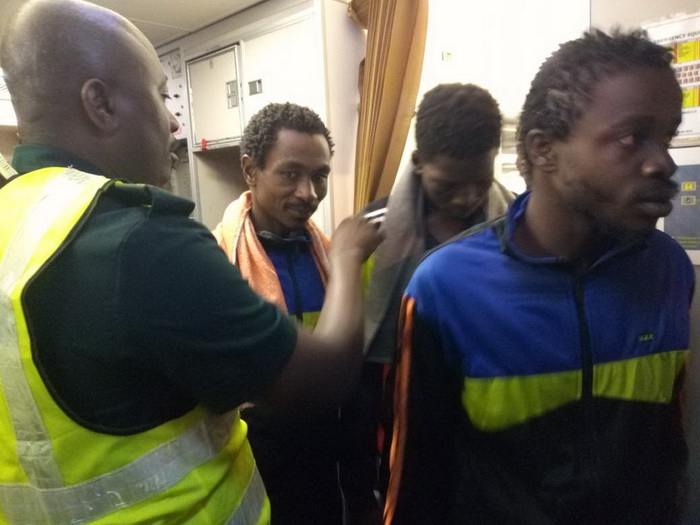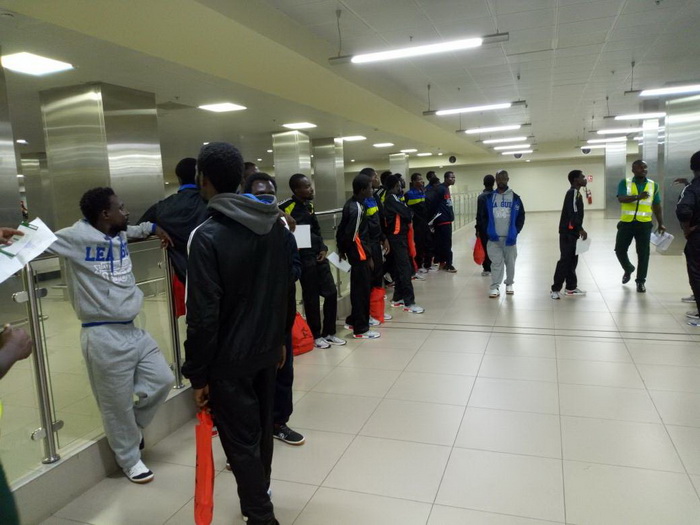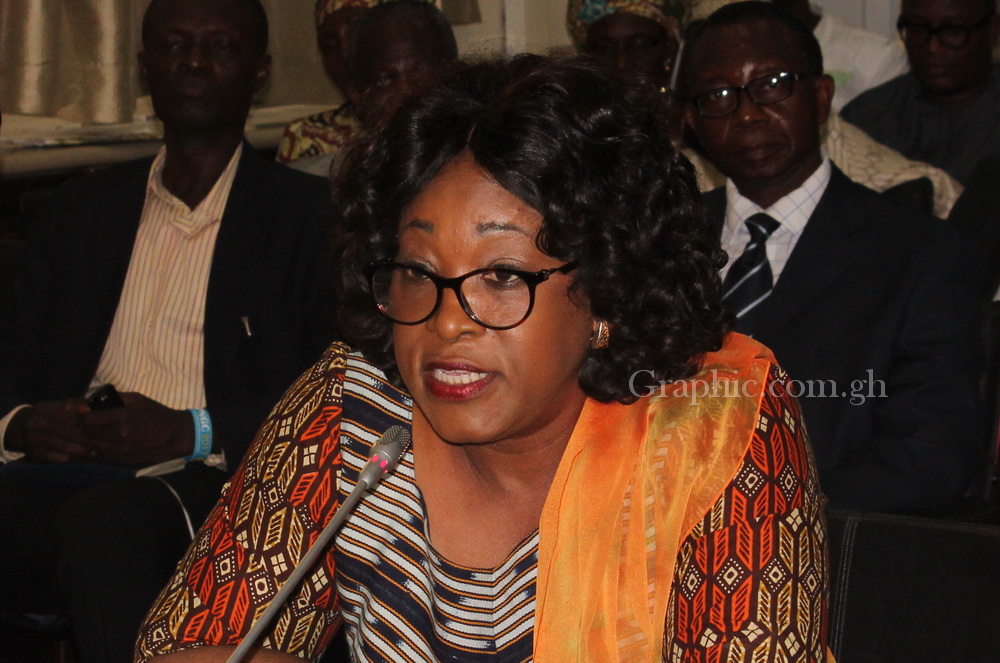
Ghanaians in Libya return and share tales of horror
One hundred and twenty-seven Ghanaian migrants, including two children, who were detained in Libya on illegal migration charges returned home last Wednesday night.
Advertisement
The returnees, whose release was facilitated by the government, landed at the Kotoka International Airport (KIA) at about 9.40 p.m aboard Afriqiyah and Air Libya aircraft.
Age, gender & regions
Out of the number, 125 are males and two are females. Thirteen of the illegal migrants are between 11 and 20 years; 68 between 21 and 30 years; 41 between 31 and 40 years, three above 41 years, while two are under 10 years.
A breakdown of the numbers indicates that Western Region topped the list of returnees with 30 people, followed by Brong Ahafo, 29; Central Region, 23; Ashanti Region 18; Upper East Region, 11; Eastern Region and Greater Accra regions, six each; Volta Region, three, and Northern Region, two.
Read also: NDC govt will never legalise same-sex marriage – Asiedu Nketia
Tales of abuse
The returnees were met on arrival by government officials and a delegation from the International Migration Organisation (IOM).
They looked frail, emaciated and tired. Some of them recounted horrifying tales of physical, verbal and emotional abuse, murder and robbery that they had suffered.
They wore black uniformed tracksuits with blue and green stripes on the jackets and sneakers to match.
“I have seen people die from being whipped with belts, hit by guns, shot and forced to crawl on their knees and called useless African slave.
“We lost money earned from doing jobs such as plastering. They just stormed our rooms and hideouts with guns and carried everyone away. Women were beaten and raped. You could not complain. We were afraid to even go and urinate because we might be beaten. It was a scary experience,” one of them, who gave his name only as Osei, said.
As they stepped out of the airport to join Metro Mass Transit buses, some shed tears but said they were grateful to God for their lives.
“I thought I would die. I gave up hope because all you hear every day were bombs and gunshots,” another said before hurriedly boarding the bus.
To pay for transport to their various destinations, each of the returnees received a little over GH¢400 from the IOM.

Journey to Europe
Libya is a transit point to Europe for thousands of African youth from mainly East and West Africa, particularly Ghana, Nigeria, Senegal, Cote d’Ivoire, Sudan, Eritrea, Ethiopia and Somalia, fleeing conflicts and economic hardship.
Experts say given that most of the migrants were undocumented and travelling through the Sahara Desert, it is difficult to put a figure on the number of illegal migrants trekking to Libya to make their way to Europe through the Mediterranean Sea.
“There is a substantial number of people and considering the situation in Libya at the moment, the difficult living conditions in the detention centres, we really are in a humanitarian crisis situation, and it is extremely important to get these people out of Libya as soon as possible,” Ms Sylvia Lopez, the Country Director of IOM, Ghana, said.
Statistics
Last year, more than 5,000 migrants died crossing the Mediterranean Sea in a disaster which the United Nations (UN) refugee agency said was the “worst annual death toll ever seen.”
The IOM’s statistics indicate that as of April this year, almost 37,000 migrants or refugees had entered Italy by sea, with more than 1,000 dying along the route.

Latest migrants media storm
The latest storm over the migrant crisis in Libya is from a CNN documentary which showed sub-Saharan Africans being offered for sale in an auction.
Libya has never been at peace with itself ever since the government of Colonel Muamar Al-Gadafi was brought to its knees in October 2011 after a six-month uprising and ensuing civil war, which resulted in his death.
A number of sub-Saharan Africans, including Ghanaians, were reportedly killed or thrown into Libyan jails because they were allegedly hired as mercenaries by Col Gaddafi.
Solutions
A migration expert, Dr Delali Badasu, told the Daily Graphic that the migration crisis today went beyond poverty as there were migrants who sold their property to sojourn to Libya and beyond.
Dr Badasu, a former Director of the Centre for Migration Studies of the University of Ghana, called for a sustained campaign to stem the irregular migration trend through engaging university and senior high school students and the unemployed on the dangers of illegal migration.
She said the government could also work with countries for bilateral arrangements to make it possible for migrants to travel and work.

Foreign Minister
Meanwhile, the Minister of Foreign Affairs, Ms Shirley Ayorkor Botchway, has confirmed the arrival of 127 Ghanaians held as illegal migrants in Libya to Ghana, writes Musah Yahaya Jafaru.
Presenting a statement in Parliament yesterday on the plight of Ghanaian nationals in Libya, Ms Botchway said 168 illegal Ghanaian immigrants had been identified in three centres in Libya by Ghana's Mission in Malta and the IOM.
She noted that the migrants were arrested on illegal migration charges.
Ms Botchway indicated that there has not been any evidence of any Ghanaian traded as a slave in Libya.
She said due to the difficulty in accessing some areas in Libya as a result of conflicting governance structures in that country, the ministry could not say whether some Ghanaians had fallen victim to the ‘slave trade’ or not.
"They found no evidence that some of our nationals had been traded off as slaves. No one can say for certain whether or not some Ghanaians have not fallen victim to the slave trade", she said.
Ms Botchway said per the current information available to the ministry through the reports of Ghana's mission in Malta, there was no evidence of any Ghanaian being held as a slave in Libya.
She commended the IOM for collaborating with the Ghana Immigration Service (GIS) in the medical screening, transportation and related services to the migrants.
Ransom for detainees
Ms Botchway said some family members of the Ghanaian detainees had to pay ransom, some as much as $5,000 to secure their release.
"It is possible that those detainees whose families could not mobilise resources to pay the ransom have been sold off," she said.
Addressing migration
Ms Botchway said in a discussion between the Ministry of Foreign Affairs and Regional Integration and the IOM that a number of facts emerged.
Evacuations from the past
March 2011
At the peak of the Libyan crisis in March 2011, statistics from the Ministry of Foreign Affairs and Regional Integration indicated that almost 17,000 Ghanaian migrants were evacuated.
March 2000
However, attacks on black Africans in Libya did not start today. On October 8, 2000, the first batch of 238 Ghanaians fleeing from attacks against black Africans in Libya arrived in Accra with sad tales of how they escaped death.
The evacuees, who were brought on a special Ghana Airways flight, included women, children, the injured and the sick, one of whom was brought home in a wheelchair.
April 2017
In April this year, more than 300 Ghanaians living in Libya voluntarily returned to Ghana as they struggled to cope with the harsh conditions in the war-ravaged North African country.
July, 2017
On July 27, 2017, an IOM chartered flight from Libya brought home 138 Ghanaians (135 men and three women) who were among the many Ghanaians living in irregular situations in Libya, often in very difficult conditions, who had opted to return to Ghana. Many of them had spent months and even years in detention centres there.



